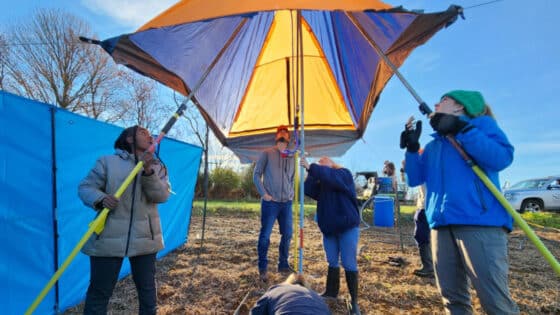Karwan, D.L., J.E. Pizzuto, R. Aalto, J. Marquard, A. Harpold, K. Skalak, A. Benthem, D.F. Levia, C.M. Siegert, and A.K. Aufdenkampe. 2018. Water Resources Research, 54.
https://doi.org/10.1029/2017WR021684 (Open access)
Abstract
Fallout radionuclides (FRNs) and their ratios, such as Beryllium‐7 (7Be) and excess Lead‐210 (210Pbxs), have been used to determine suspended sediment source and age in catchments. These models are based on numerous assumptions, for example, that channel deposition of FRNs from precipitation is negligible in comparison to their delivery to the channel from land surface erosion during individual storm events. We test this assumption using a mass balance approach during 8 storms from summer 2011 – fall 2012 in a mid‐Atlantic USA piedmont region watershed with mixed landuse. Event peak discharge and storm type corresponded to the importance of direct channel FRN deposition from precipitation. During relatively low‐discharge summer thunderstorms, with minimal overland flow, less than 1% of 7Be and 210Pbxs flux deposited on the watershed exits the watershed associated with suspended sediment. The majority but not all deposited on the stream channel exits the watershed associated with suspended sediment (60% of 7Be and 80% of 210Pbxs). Here, precipitation and throughfall onto the wetted channel area can be responsible for any FRN newly‐associated with suspended sediment, as opposed to landscape surface erosion. Furthermore, FRNs can be stored with sediments in the channel between events. Events with higher discharges, including hurricanes, show the opposite pattern — FRN flux associated with suspended sediment exported from the reach is greater than channel FRN wet deposition, suggesting net erosion from the watershed landscape and/or stored material during these types of storms.
Funding
Funding for this work was provided by the National Science Foundation to DLK as a Postdoctoral Fellow (EAR 1144760), to DLK, JP, and KS in EAR 1424147, and to the Christina River Basin Critical Zone Observatory (NSF EAR 1331856).


